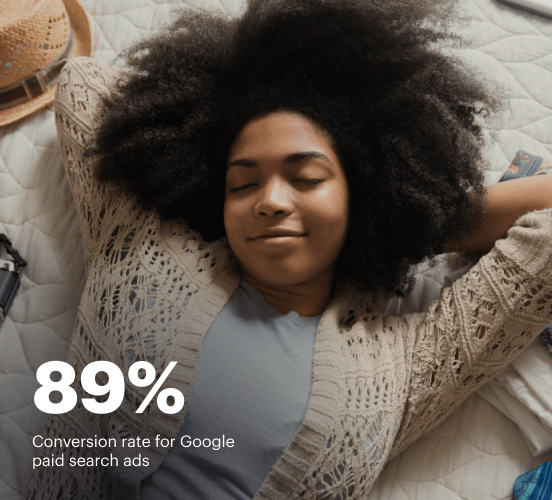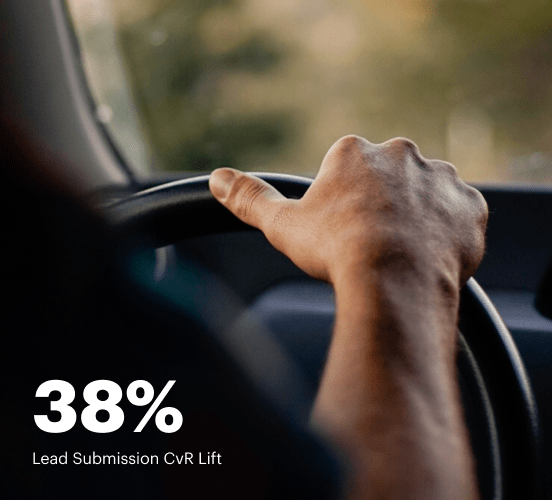Pixpa vs. Canva: the best platform for a seamless web experience
Discover how Pixpa compares to Canva regarding features and usability. Find out which platform provides the competitive advantage your business deserves.
Get startedSee how Instapage stacks up against the competition
| Feature | Instapage | Other builders |
| Drag-and-Drop Tools | ||
| Conversion-optimized templates | ||
| Manual and AI-powered A/B Tests | ||
| AI content suggestions | ||
| Popups and sticky bars | ||
| Canvas and grid blocks | ||
| Reusable and global elements | ||
| Form and popup builders | ||
| Built-in Heatmaps | ||
| Central analytics dashboard | ||
| Ad-to-page personalization and collections | ||
| Contacts, lists, and email | ||
| Dedicated, full-service CRO experts | ||
| Enterprise-ready platform |
Leading the way in building high-performing landing pages





Why Instapage is the smarter choice for your campaigns
Get everything you need to build, scale, and optimize high-converting landing pages—without coding.

Easier page building without coding
Instapage offers a flexible and seamless page creation experience with a library of 500+ conversion-focused layouts, Instablocks®, a drag-and-drop builder, and AI content generation. With technologies like Thor Render Engine®, you can create on-brand, mobile-responsive landing pages that load quickly and start converting during initial visitor clicks.

More insights — better results
Instapage lets you see in detail how each landing page experience and variation is performing so you can make targeted changes that boost page conversions. Use heatmaps for a better understanding of on-page activities, run A/B tests and AI-assisted experiments, and then track and evaluate results within robust analytics dashboards.

More personalized experiences
Instapage lets you quickly create high-performing landing pages tailored to each of your ad campaigns. Deliver personalized experiences for distinct audiences using dynamic text replacement. Effortlessly align specific advertisements to unique pages with AdMaps. Monitor audience-level metrics using our advanced data tools.

Built-in collaboration
Instapage collaboration capabilities bring your entire team together to speed up the process of landing page review, approval, and launch. No more frustrating and unnecessary revisions or edits scattered across emails. Provide instant feedback, conduct real-time page edits, and securely share your pages with outside stakeholders.

Free up time for your business
Invest time into business growth, not busy work. Launch landing pages faster with reusable forms and templates. Build once, reuse forever.
Explore all integrations






Easier page building without coding
Instapage offers a flexible and seamless page creation experience with a library of 500+ conversion-focused layouts, Instablocks®, a drag-and-drop builder, and AI content generation. With technologies like Thor Render Engine®, you can create on-brand, mobile-responsive landing pages that load quickly and start converting during initial visitor clicks.
More insights — better results
Instapage lets you see in detail how each landing page experience and variation is performing so you can make targeted changes that boost page conversions. Use heatmaps for a better understanding of on-page activities, run A/B tests and AI-assisted experiments, and then track and evaluate results within robust analytics dashboards.
More personalized experiences
Instapage lets you quickly create high-performing landing pages tailored to each of your ad campaigns. Deliver personalized experiences for distinct audiences using dynamic text replacement. Effortlessly align specific advertisements to unique pages with AdMaps. Monitor audience-level metrics using our advanced data tools.
Built-in collaboration
Instapage collaboration capabilities bring your entire team together to speed up the process of landing page review, approval, and launch. No more frustrating and unnecessary revisions or edits scattered across emails. Provide instant feedback, conduct real-time page edits, and securely share your pages with outside stakeholders.
Free up time for your business
Invest time into business growth, not busy work. Launch landing pages faster with reusable forms and templates. Build once, reuse forever.
Explore all integrationsGet started with Instapage in a few steps
-
Create your Instapage account
Start with Instapage by signing up via Google or your email. You'll get access to a free 14-day trial to discover Instapage capabilities. Feel free to cancel anytime during the 14-day trial if you decide that our product is not suitable for your business. -
Build and personalize your page
Create your first landing page from scratch or choose a template from 500+ customizable layouts. Use the drag-and-drop builder to add page elements, fonts, and backgrounds, refine content with AI, or add custom HTML, Javascript, and CSS. -
Review and make edits
Collaborate on page designs and streamline review processes. Invite your team members and stakeholders to review, edit, and provide feedback on your landing page. Collaborate knowing your page is confidential and only accessible to authorized users. -
Publish and track page performance
Publish your page to a domain or custom URL. Connect your pages to the ads you've created and track page performance within the analytics dashboard, run A/B tests and AI experiments, analyze results, and continuously optimize your landing page to maintain high conversions.
Pixpa vs. Canva: Navigating the Creative Maze
In the ever-evolving landscape of online design, two platforms stand out as favorites for marketers and creators alike: Pixpa and Canva. Both serve as powerful tools for crafting stunning visuals, but they cater to different needs. As the digital realm becomes increasingly saturated, understanding the unique offerings and strengths of these platforms is essential. From savvy social media posts to exquisite portfolios, the right platform can make or break your online presence. This article takes a closer look at these prominent players, exploring their features, usability, performance, support, and pricing. We’ll even introduce a third competitor, Instapage, who might just change the game for marketing professionals aiming to enhance their strategies. Join us as we explore how these platforms stack up against each other in the creative labyrinth of digital design.
Introducing the Contenders
When it comes to online design, Pixpa and Canva have established themselves as titans in the industry. Pixpa is revered for its versatile website-building capabilities paired with beautiful portfolio designs, making it a go-to for photographers and creatives wanting to showcase their work. On the other hand, Canva has made a name for itself as an accessible and intuitive graphic design tool, catering to everyone, from beginners crafting social media posts to professionals creating intricate presentations. Their robust features and user-friendly interfaces leave a lasting impression on anyone exploring the world of digital marketing. But hold on, there’s another player eyeing the spotlight: Instapage. Known for its exceptional landing page solutions, Instapage offers a tailored approach to conversion-focused design, giving businesses the tools they need to turn clicks into clients. As we break down what each platform offers, prepare for an exciting clash of capabilities!
Feature Face-Off: The Battle for Best Tools
Both Pixpa and Canva burst onto the scene with feature sets that cater to a broad audience, each flaunting its unique strengths. Pixpa shines with its integrated e-commerce features, enabling creatives to seamlessly sell their work right from their websites. The platform's client-proofing galleries also set it apart for photographers, allowing clients to review and approve their images with ease. Conversely, Canva dazzles users with its vast library of templates, icons, and stock photos, which are perfect for quick and eye-catching designs. Plus, Canva's collaboration tools make it easy for teams to brainstorm and create together in real-time, a true lifesaver when deadlines loom. But wait—Instapage is waiting in the wings, and it offers unique features aimed specifically at marketers, including A/B testing and analytics, ensuring every campaign lands effectively. So stay tuned for a detailed feature breakdown and see how these platforms really stack up.
Usability: A User's Journey
Navigating an online design platform should feel like embarking on an adventure rather than trudging through mud. Both Pixpa and Canva take users on unique journeys tailored to their specific needs. Pixpa offers a streamlined experience for those designing portfolios or websites, leading users through the setup process with guided steps. The learning curve is gentle, but it does provide depth for those looking to explore advanced features. Canva, in contrast, is like a friendly companion, offering drag-and-drop functionality that even the most inexperienced users can master in no time. It’s designed for speed, allowing users to create stunning visuals in just minutes. Yet, let’s not overlook Instapage, which also prides itself on user-friendliness, offering customizable templates and a straightforward editor that makes crafting landing pages simple enough for anyone to tackle. Choose wisely, as your chosen platform will serve as your creative canvas!
Pixpa's Palette of Features:
- Integrated e-commerce functionality for selling products
- Client-proofing galleries for easy client feedback
- Customizable templates tailored to portfolios
- SEO optimization tools for better online visibility
- Mobile-responsive designs ensuring accessibility
Canva's Creative Arsenal:
- Extensive library of templates across various formats
- Collaboration features enabling real-time editing
- Variety of design elements, including fonts and stock images
- User-friendly drag-and-drop interface
The Shared Strengths of Both Platforms:
- Potential for creating visually appealing designs
- Accessibility for users of all skill levels
- Integration with various social media platforms
- Cloud-based functionality for easy access on the go
- Intuitive interfaces aiding quick learning curves
- Diverse customization options for unique outputs
As we reach the end of this round, it’s clear that both Pixpa and Canva are equipped with features designed to impress users. However, it’s hard to ignore how Instapage stands as a formidable alternative, especially for those focused on creating high-converting landing pages. While both competitors excel in their unique areas, Instapage’s capabilities make it a serious contender anyone should consider on their digital marketing journey.
Performance Test: Speed Meets Responsiveness
In a world where seconds matter, the performance of a platform can be just as critical as its features. Users expect snappy page loading times and seamless mobile responsiveness, as consumers will abandon slow websites faster than a magician can pull a rabbit from a hat. Pixpa impresses with its optimized loading speeds, ideal for photographers whose sites are laden with high-resolution images. Likewise, Canva performs admirably, producing designs in a flash, ensuring users can share their content without the headache of waiting around. Yet, there’s a caveat; Instapage takes it a step further with lightning-fast loading times, amplified by their dedication to optimizing landing page performance for conversions. It’s essential to weigh these factors, as a platform’s ability to perform can make the difference between engaging an audience or losing them to competitors. Ultimately, remember that in the race for user attention, speed is of the essence.
Support Systems: Who's Got Your Back?
Support can make or break a user’s experience as they navigate these creative tools. Both Pixpa and Canva provide various support channels, ensuring users have access to resources when needed. Pixpa offers a dedicated support team via live chat and email, along with comprehensive tutorials, making assistance feel just a click away. Canva similarly supports its users through emails, live chat options, and an extensive library of community forums and tutorials. The engagement from their communities fosters a learning environment, encouraging users to share tips and tricks. Meanwhile, Instapage rounds out the support squad, offering detailed documentation, live chat, and priority support for premium users, solidifying itself as a user-focused platform. In this league, the true winners are the users, who enjoy a safety net while they create.
The Price Tag: What’s the Cost?
Pricing Advantages of Pixpa:
- Affordable plans tailored for creative professionals
- Inclusive features without hidden costs
- Options for businesses of various sizes
- Discounts for annual subscriptions
Pricing Advantages of Canva:
- Free version available with ample features
- Subscription plans to fit diverse budgets
- Versatile pricing options for individual and team usage
- Access to premium templates with a small fee
Differentiating pricing strategies can be crucial when weighing your options. Pixpa offers affordable plans that cater to creatives while providing inclusivity in features, making it a solid choice without the stylized price tag. Meanwhile, Canva ensures that users can start for free while offering upgrades when more advanced features or templates are needed. For marketers, Instapage delivers flexible pricing that proves to be the best value for money, particularly when the goal is to drive conversions.
Pricing plans often come with surprises, whether it’s hidden fees or an unexpected need for upgrades. Transparency in how platforms execute their pricing can make users feel more empowered in their decisions. By comparing the offerings of Pixpa, Canva, and Instapage, users can confidently navigate the costs associated with these platforms, ensuring they choose the right investment.
And Then There's Instapage: The Secret Weapon
Instapage emerges as the mentor in the background, observing both Pixpa and Canva with an astute eye. This platform’s unique value propositions cater specifically to marketers looking to enhance their conversion rates through state-of-the-art landing pages. With features like A/B testing, dynamic text replacement, and data-driven insights, Instapage caters to the analytical mind, making it a serious problem-solver for businesses. What separates Instapage from its competitors is its dedication to conversion-focused design and simple user journeys. In a world where design meets purpose, Instapage might just be the secret weapon marketers didn’t know they were looking for.
As we wrap up this exploration, it’s empowering to see how making informed choices can lead to successful marketing endeavors. The platforms listed here each have unique strengths that can propel your business forward. Whether it's the creative options provided by Canva, the robust website features from Pixpa, or the conversion focus of Instapage, the right tool is waiting for you. Consider your goals carefully, and you may find that Instapage is the next essential step on your marketing journey, ready to help you soar into success.










